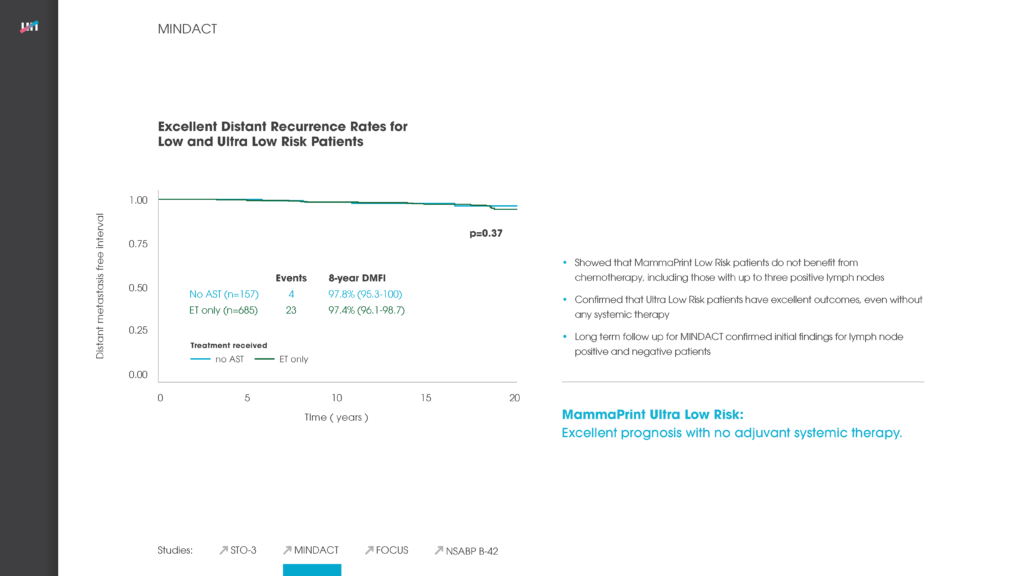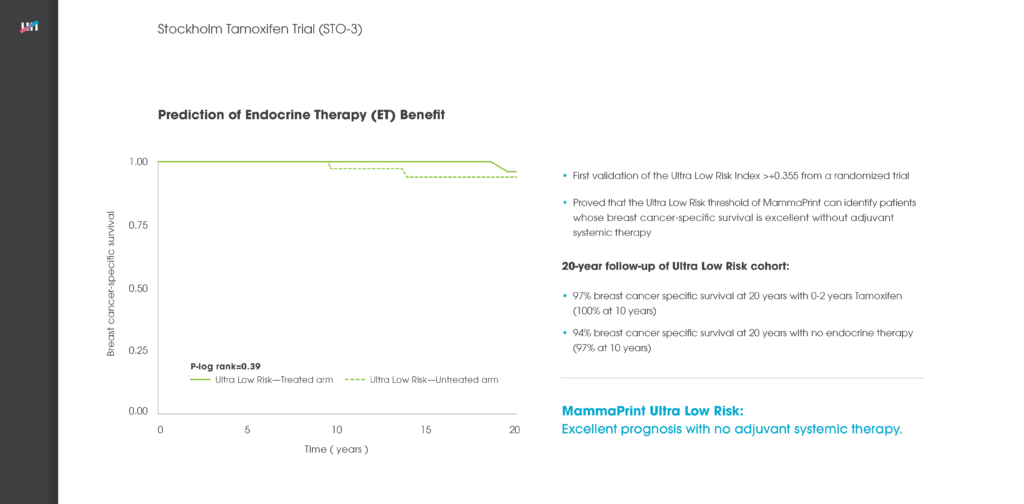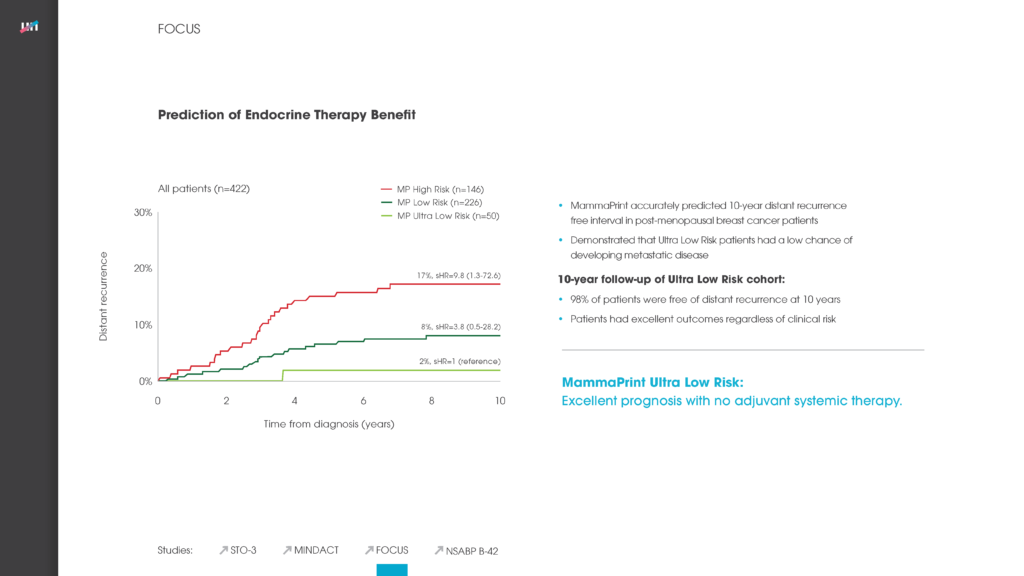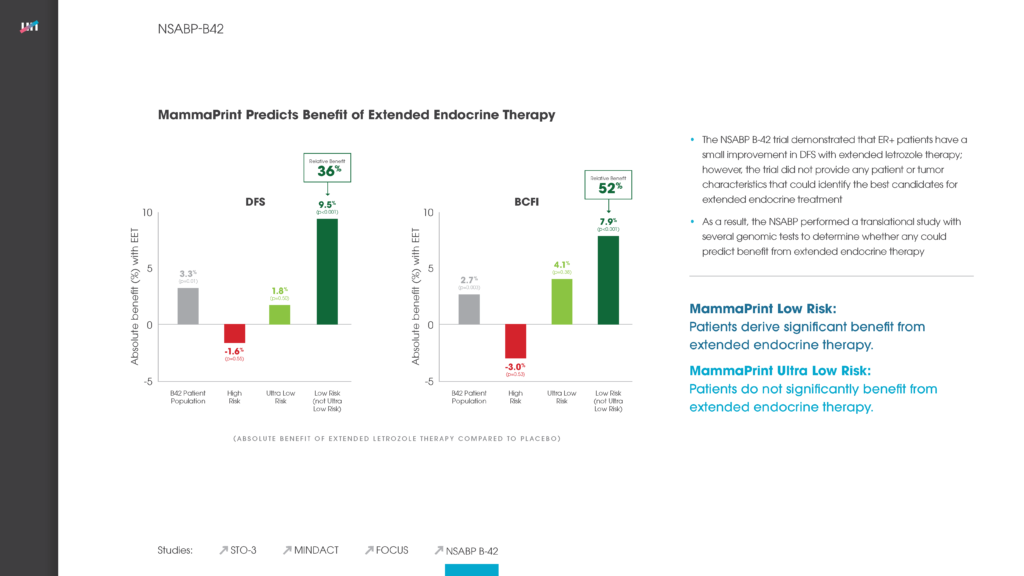One of the biggest questions that early-stage breast cancer patients face is whether they will benefit from chemotherapy treatment. Two large scale randomized clinical trials that implement genomic testing have positively addressed this question.
The recent results from the TAILORx clinical trial evaluating Oncotype DX are important for patients and their oncologists, but they also raised questions and concerns regarding the appropriate treatment strategies for certain women with early-stage breast cancer, and the results should be carefully evaluated for each group of patients.
Patients who have had MammaPrint genomic testing should be assured that the findings from the TAILORx trial do not change or in any way impact the MammaPrint test, which has remained consistent and credible since the test was introduced more than a decade ago, and for which the MINDACT trial provided the highest level of evidence in 2016.
To best understand the utility for treatment decisions, it is important to recognize the differences between the TAILORx trial and the MINDACT trial, the landmark trial supporting the clinical utility of MammaPrint.
For clinically low-risk women, TAILORx confirmed lack of chemotherapy benefit
In post-menopausal women over the age of 50 with small (1-2 cm), low-grade and lymph-node negative tumors and an Oncotype DX intermediate score tumor, the TAILORx study found they are unlikely to see significant benefit from chemotherapy and have a good prognosis with endocrine treatment alone. These women represented 74% of patients in the TAILORx trial. These same women were actually found to be clinically low risk for breast cancer recurrence by MammaPrint in the MINDACT trial, and solely based on the clinical criteria were not considered for chemotherapy with excellent outcomes.
TAILORx was not able to provide clear answers about the benefits of chemotherapy treatment in four important groups of women in the trial:
- Women who are clinically high risk with larger (>2 cm) or higher grade tumors
- Women age 50 or under with an Oncotype DX intermediate risk score of 16-25
- Women with a Oncotype DX intermediate risk score of 26-30
- Women with lymph-node positive (1-3 nodes) tumors
Additionally, TAILORx made interpreting Oncotype DX results even more complicated by dividing the women in the intermediate risk score group (16-25) into smaller subgroups to address their need for chemotherapy. Not only did they not provide clear answers for these subgroups, but this change to the TAILORx trial design has created more confusion and less clarity for patients and physicians.
For both low risk and high risk patients, MammaPrint can answer questions raised by TAILORx for the Oncotype DX test
MammaPrint is backed by the landmark MINDACT trial, a prospective Phase III trial published in the New England Journal of Medicine in 2016 that focused on clinically high-risk women for whom genomic testing would truly make a difference.
- In this practice-changing trial, MammaPrint demonstrated that nearly half of all women with clinically high-risk features were actually at low genomic risk for breast cancer recurrence and therefore unlikely to see any significant benefit from chemotherapy. In addition, MINDACT showed that clinically low-risk patients could avoid chemotherapy.
- Additionally, MammaPrint provided clear results for women age 50 or under – a group comprising nearly one-third of MINDACT patients – and removed any uncertainty about the benefits of chemotherapy in this patient population.
- MammaPrint offers clear binary results and avoids the complication of intermediate risk scores.
- MammaPrint is currently the only test of its kind recommended by the American Society of Clinical Oncology (ASCO)’s breast cancer clinical practice guidelines for women with lymph-node positive breast cancer patients – for whom it was shown that MammaPrint low-risk patients did not derive a clinical meaningful benefit of chemotherapy.
By specifically studying clinically high-risk patients, the MINDACT trial found that 46% of these patients can forgo chemotherapy without impacting their outcomes. The MINDACT trial further showed that MammaPrint testing facilitates informed treatment decisions independent of a tumor’s pathological or clinical factors and can be effectively used in both low risk and high risk patients. These findings clearly establish MammaPrint as the gold standard for risk of disease recurrence in women of all ages with early-stage breast cancer.
MammaPrint offers best-in-class precision oncology to empower treatment decisions
Over the past decade, MammaPrint has helped thousands of women avoid potentially unnecessary treatments by providing clear and consistent results about their risk of breast cancer recurrence. In this way, MammaPrint empowers patients and their physicians to make better informed and individualized treatment management decisions.
William Audeh, MD, MS
Chief Medical Officer, Agendia

















